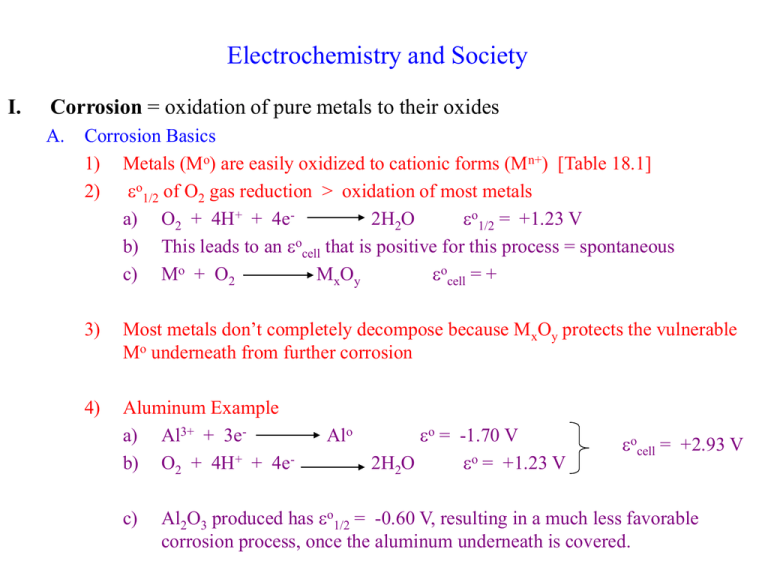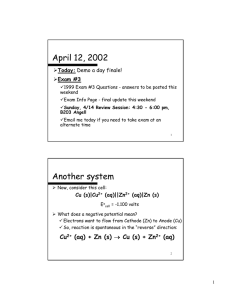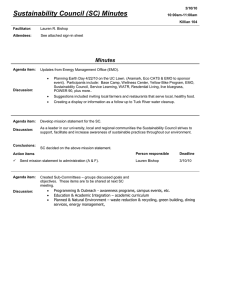Electrochemistry and Society I. Corrosion
advertisement

Electrochemistry and Society I. Corrosion = oxidation of pure metals to their oxides A. Corrosion Basics 1) Metals (Mo) are easily oxidized to cationic forms (Mn+) [Table 18.1] 2) eo1/2 of O2 gas reduction > oxidation of most metals a) O2 + 4H+ + 4e2H2O eo1/2 = +1.23 V b) This leads to an eocell that is positive for this process = spontaneous c) Mo + O2 MxOy eocell = + 3) Most metals don’t completely decompose because MxOy protects the vulnerable Mo underneath from further corrosion 4) Aluminum Example a) Al3+ + 3eb) O2 + 4H+ + 4ec) Alo eo = -1.70 V 2H2O eo = +1.23 V eocell = +2.93 V Al2O3 produced has eo1/2 = -0.60 V, resulting in a much less favorable corrosion process, once the aluminum underneath is covered. 5) B. The “Noble Metals” (Ag, Au, Cu, Pt) do not react with oxygen as easily a) Auo eo1/2 = +1.50 V no corrosion b) Ago eo1/2 = +0.80 V Ag2S tarnish formed instead of the oxide c) Cuo eo1/2 = +0.16 V Cu2CO3 forms green “patina” The Corrosion of Iron 1) This is the most economically important corrosion process due to structural steel 2) Steel has a non-uniform surface due to physical stress a) Anodic Region: Fe Fe2+ + 2eb) Cathodic Region: O2 + 2H2O + 4e4OH3) Fe2+ then acts as the salt bridge electrolyte if wet (added salt speeds up corrosion) Cathode: 4Fe2+ + O2 (4 + 2n)H2O 2Fe2O3 • nH2O + 8H+ C. Preventing Corrosion 1) Paint covers the surface to prevent the contact of oxygen and the metal 2) Plating steel with Cr or Sn to produce very stable oxides 3) Galvanizing = coating with Zinc a) Fe Fe2+ + 2e-eo1/2 = +0.44 V b) Zn Zn2+ + 2e-eo1/2 = +0.76 V c) Corrosion occurs on Zn rather than Fe (sacrificial coating) -eo1/2 ~ Noble metal 4) Stainless Steel = Fe + Cr + Ni 5) Cathodic Protection = protects buried steel or ships with a sacrificial reactant a) Active metal (Mg) connected to pipe by a wire -eo1/2 = +2.37 V b) Bars of Ti attached to ship -eo1/2 = +1.60 V II. Electrolysis = using electric energy to produce chemical change (opposite of cell) A. Example 1) Consider the Cu/Zn Galvanic Cell a) Anode: Zn Zn2+ + 2eb) Cathode: Cu2+ + 2eCu eocell = +1.10 V 2) If we attach a power source of eo > +1.10 V, we can force e- to go the other way a) Anode: Cu Cu2+ + 2eb) Cathode: Zn2+ + 2eZn c) Called an Electrolytic Cell B. Calculations with Electrolytic Cells 1) How much Chemical Change? Is usually the question. 2) Find mass of Cuo plated out by passing 10 amps (10 C/s) through Cu2+ solution. a) Cu2+ + 2eCuo(s) b) Steps: current/time, charge (C), moles e-, moles Cu, grams Cu (10 C/s)(30 min)(60 s/min) 18,000 C 1 mol e - (18,000 C) 0.187 mol e 96,485 C 1 mol Cu (0.187 mol e-) 0.0935 mol Cu 2 mol e (0.0935 mol Cu)(63.546 g/mol) 5.94 g Cu Example: How long must a current of 5.00 amps be applied to a Ag+ solution to produce 10.5 g of silver metal? Electrolysis of Water 1) Galvanic: 2H2 + O2 2H2O (Fuel Cell) 2) Electrolytic Cell: a) Anode: 2H2O O2 + 4H+ + 4e-eo = -1.23 V b) Cathode: 4H2O + 4e2H2 + 4OHeo = -0.83 V c) Overall: 6H2O 2H2 + O2 + 4(H+ + OH-) 2H2O 2H2 + O2 eocell = -2.06 V 3) We must add a salt to increase the conductance of pure water [H+] = [OH-] = 10-7 3) C. D. Electrolysis of Mixtures 1) Mixture of Cu2+, Ag+, Zn2+; What is the order of plating out? a) Ag+ + eAg eo1/2 = +0.80 V b) Cu2+ + 2eCu eo1/2 = +0.34 V c) Zn2+ + 2eZn eo1/2 = -0.76 V 2) Reduction of Ag+ is easiest (eo = most positive) followed by Cu, then Zn 3) Example: Ce4+ (eo1/2 = +1.70 V), VO2+ (eo1/2 = +1.00 V), Fe3+ (eo1/2 = +0.77 V) III. Commercial Electrolytic Processes A. Production of Aluminum 1) Most metals are found naturally as their oxides, MxOy 2) Only the noble metals are typically found as the pure metal 3) Bauxite = aluminum ore; Al2O3 4) Aluminum is the third most abundant element on crust (oxygen and silicon) 5) No commercial process for pure Al until 1854 (eo1/2 = 1.66 V) 6) Al was more valuable than gold or silver 8) Hall—Heroult Process a) Al3+ + 3 eAl eo1/2 = -1.66 V b) 2H2O + 2eH2 + 2OHeo1/2 = -0.83 V c) Can’t make Al in water because water gets reduced before Al3+ d) Use molten Al2O3/Na3AlF6 mixture at 1000 oC 9) Aluminum alloys with Zn, Mn are most useful because they are stronger 10) Aluminum production uses 5% of the electricity consumed in the U.S. B. Electrorefining = purification of metals 1) Impure Cuo anode: Cuo Cu2+ + 2e2) Pure Cuo cathode: Cu2+ + 2eCuo (99.95% pure) 3) Also useful for purification of Zn, Fe 4) Gold, Silver, Platinum fall to the bottom of the tank as sludge (won’t plate out) C. Metal Plating 1) Coat easily corrodable metal object with a noble metal 2) Ag+ + eAgo on a spoon D. Electrolysis of NaCl 1) Production of Na metal from NaCl in a “Downs Cell” a) Anode: 2ClCl2 + 2eb) Cathode: Na+ + eNao c) Cell is designed to to keep products apart so they can’t reform NaCl 2) Production of Cl2, OH- in a Mercury Cell a) Water is reduced to OH- (eo1/2 = -0.83 V) before Na+ (eo1/2 = -2.71 V) b) Anode: 2ClCl2 + 2ec) Cathode: 2H2O + 2eH2 + 2OHd) Chlor-Alkali Process = second largest electricity user in U.S. (after Al) Downs Cell Mercury Cell for Chor-Alkali Process



